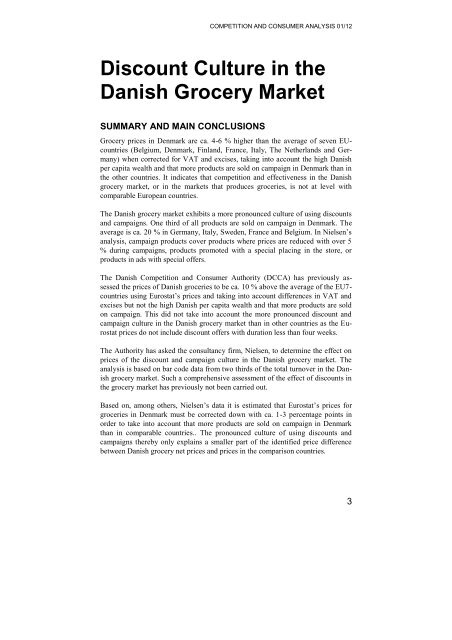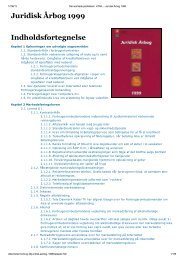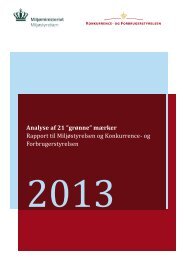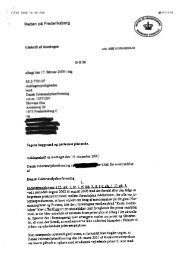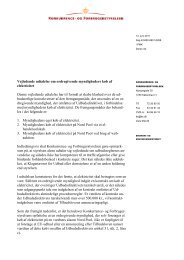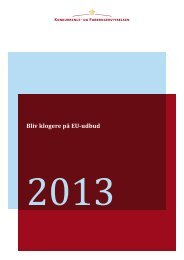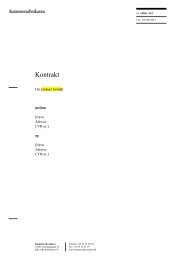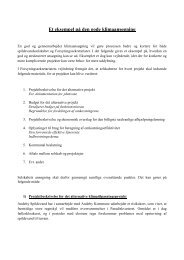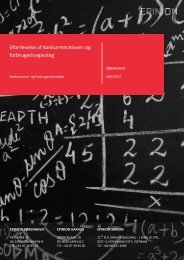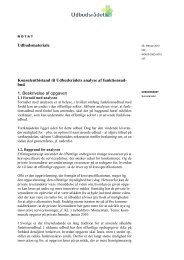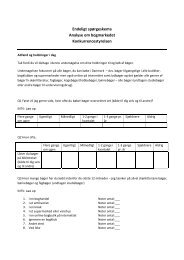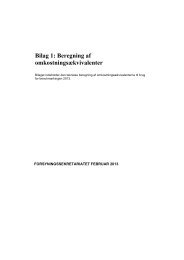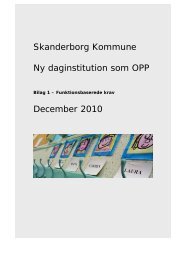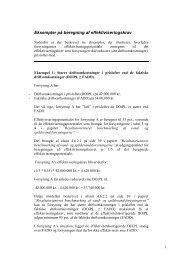Discount Culture in the Danish Grocery Market
Discount Culture in the Danish Grocery Market
Discount Culture in the Danish Grocery Market
Create successful ePaper yourself
Turn your PDF publications into a flip-book with our unique Google optimized e-Paper software.
COMPETITION AND CONSUMER ANALYSIS 01/12<br />
<strong>Discount</strong> <strong>Culture</strong> <strong>in</strong> <strong>the</strong><br />
<strong>Danish</strong> <strong>Grocery</strong> <strong>Market</strong><br />
SUMMARY AND MAIN CONCLUSIONS<br />
<strong>Grocery</strong> prices <strong>in</strong> Denmark are ca. 4-6 % higher than <strong>the</strong> average of seven EUcountries<br />
(Belgium, Denmark, F<strong>in</strong>land, France, Italy, The Ne<strong>the</strong>rlands and Germany)<br />
when corrected for VAT and excises, tak<strong>in</strong>g <strong>in</strong>to account <strong>the</strong> high <strong>Danish</strong><br />
per capita wealth and that more products are sold on campaign <strong>in</strong> Denmark than <strong>in</strong><br />
<strong>the</strong> o<strong>the</strong>r countries. It <strong>in</strong>dicates that competition and effectiveness <strong>in</strong> <strong>the</strong> <strong>Danish</strong><br />
grocery market, or <strong>in</strong> <strong>the</strong> markets that produces groceries, is not at level with<br />
comparable European countries.<br />
The <strong>Danish</strong> grocery market exhibits a more pronounced culture of us<strong>in</strong>g discounts<br />
and campaigns. One third of all products are sold on campaign <strong>in</strong> Denmark. The<br />
average is ca. 20 % <strong>in</strong> Germany, Italy, Sweden, France and Belgium. In Nielsen’s<br />
analysis, campaign products cover products where prices are reduced with over 5<br />
% dur<strong>in</strong>g campaigns, products promoted with a special plac<strong>in</strong>g <strong>in</strong> <strong>the</strong> store, or<br />
products <strong>in</strong> ads with special offers.<br />
The <strong>Danish</strong> Competition and Consumer Authority (DCCA) has previously assessed<br />
<strong>the</strong> prices of <strong>Danish</strong> groceries to be ca. 10 % above <strong>the</strong> average of <strong>the</strong> EU7countries<br />
us<strong>in</strong>g Eurostat’s prices and tak<strong>in</strong>g <strong>in</strong>to account differences <strong>in</strong> VAT and<br />
excises but not <strong>the</strong> high <strong>Danish</strong> per capita wealth and that more products are sold<br />
on campaign. This did not take <strong>in</strong>to account <strong>the</strong> more pronounced discount and<br />
campaign culture <strong>in</strong> <strong>the</strong> <strong>Danish</strong> grocery market than <strong>in</strong> o<strong>the</strong>r countries as <strong>the</strong> Eurostat<br />
prices do not <strong>in</strong>clude discount offers with duration less than four weeks.<br />
The Authority has asked <strong>the</strong> consultancy firm, Nielsen, to determ<strong>in</strong>e <strong>the</strong> effect on<br />
prices of <strong>the</strong> discount and campaign culture <strong>in</strong> <strong>the</strong> <strong>Danish</strong> grocery market. The<br />
analysis is based on bar code data from two thirds of <strong>the</strong> total turnover <strong>in</strong> <strong>the</strong> <strong>Danish</strong><br />
grocery market. Such a comprehensive assessment of <strong>the</strong> effect of discounts <strong>in</strong><br />
<strong>the</strong> grocery market has previously not been carried out.<br />
Based on, among o<strong>the</strong>rs, Nielsen’s data it is estimated that Eurostat’s prices for<br />
groceries <strong>in</strong> Denmark must be corrected down with ca. 1-3 percentage po<strong>in</strong>ts <strong>in</strong><br />
order to take <strong>in</strong>to account that more products are sold on campaign <strong>in</strong> Denmark<br />
than <strong>in</strong> comparable countries.. The pronounced culture of us<strong>in</strong>g discounts and<br />
campaigns <strong>the</strong>reby only expla<strong>in</strong>s a smaller part of <strong>the</strong> identified price difference<br />
between <strong>Danish</strong> grocery net prices and prices <strong>in</strong> <strong>the</strong> comparison countries.<br />
3
COMPETITION AND CONSUMER ANALYSIS 01/12<br />
Previous analysis has <strong>in</strong>dicated that competition is not perfect <strong>in</strong> <strong>the</strong> value cha<strong>in</strong> of<br />
bread and milk and that <strong>the</strong> productivity <strong>in</strong> <strong>the</strong> <strong>Danish</strong> grocery market is below<br />
level of several o<strong>the</strong>r countries. A lower productivity <strong>in</strong> <strong>the</strong> <strong>Danish</strong> grocery market<br />
can <strong>in</strong> <strong>the</strong> end lead to higher <strong>Danish</strong> groceries prices.<br />
One analysis of <strong>the</strong> grocery market <strong>in</strong> Denmark has shown that a change <strong>in</strong> <strong>the</strong><br />
plann<strong>in</strong>g law that allows more and larger shops, so called hypermarkets, can <strong>in</strong>crease<br />
productivity <strong>in</strong> <strong>the</strong> grocery market. The reason is that many of <strong>the</strong> small<br />
and medium sized shops will be replaced by <strong>the</strong> more productive hypermarkets.<br />
Allow<strong>in</strong>g more hypermarkets to be built <strong>in</strong> Denmark will also make entry <strong>in</strong>to <strong>the</strong><br />
<strong>Danish</strong> market more attractive for foreign grocery cha<strong>in</strong>s. This will <strong>in</strong>crease competition<br />
and allow for fur<strong>the</strong>r <strong>in</strong>crease <strong>in</strong> productivity and contribute to reduce<br />
prices.<br />
More pronounced use of unaddressed advertis<strong>in</strong>g material <strong>in</strong><br />
Denmark<br />
The <strong>Danish</strong> grocery cha<strong>in</strong>’s preferred media for communication of discounts is <strong>in</strong><br />
unaddressed advertis<strong>in</strong>g material, accord<strong>in</strong>g to a survey conducted by <strong>the</strong> DCCA.<br />
The use of unaddressed advertis<strong>in</strong>g material is more widespread <strong>in</strong> Denmark than<br />
<strong>in</strong> Norway and Sweden. In Denmark ca. 33.000 pages of unaddressed advertis<strong>in</strong>g<br />
material are published on a yearly basis whereas <strong>the</strong> comparable numbers are ca.<br />
9.000 <strong>in</strong> Sweden and 5.000 <strong>in</strong> Norway.<br />
<strong>Discount</strong>s and <strong>the</strong> market<strong>in</strong>g of discounts are very important competition parameters<br />
for <strong>Danish</strong> grocery cha<strong>in</strong>s. The use of unaddressed advertis<strong>in</strong>g material is, all<br />
else equal, a sign of competition among <strong>the</strong> exist<strong>in</strong>g grocery cha<strong>in</strong>s.<br />
Some grocery cha<strong>in</strong>s have experimented with reduc<strong>in</strong>g <strong>the</strong> use of unaddressed advertis<strong>in</strong>g<br />
material <strong>in</strong> market<strong>in</strong>g campaigns or hav<strong>in</strong>g less discount <strong>in</strong>tensive campaigns.<br />
It resulted <strong>in</strong> a fall <strong>in</strong> <strong>the</strong> stores’ turnover. The grocery cha<strong>in</strong>s participat<strong>in</strong>g<br />
<strong>in</strong> <strong>the</strong> DCCA’s survey assess on average that <strong>the</strong>ir turnover would fall with between<br />
one forth and one third if <strong>the</strong>y would stop publish<strong>in</strong>g unaddressed advertis<strong>in</strong>g<br />
material while <strong>the</strong>ir competitors would still publish <strong>the</strong>m. The <strong>in</strong>dividual bus<strong>in</strong>ess<br />
<strong>the</strong>refore has a strong <strong>in</strong>centive to cont<strong>in</strong>ue publish<strong>in</strong>g unaddressed advertis<strong>in</strong>g<br />
material. The analysis conta<strong>in</strong>s one example of a shop that has been successful<br />
<strong>in</strong> us<strong>in</strong>g alternative market<strong>in</strong>g <strong>in</strong>struments.<br />
A number of empirical studies have shown that <strong>in</strong>formative advertis<strong>in</strong>g – e.g., advertis<strong>in</strong>g<br />
of prices or discounts – reduce search costs and contribute to reduc<strong>in</strong>g<br />
<strong>the</strong> price level. Consumers read<strong>in</strong>g <strong>the</strong> grocery cha<strong>in</strong>s’ unaddressed advertis<strong>in</strong>g<br />
material and actively search for <strong>the</strong> best deals contribute to streng<strong>the</strong>n<strong>in</strong>g competition.<br />
That leads to lower prices. The benefit of some consumers be<strong>in</strong>g well-<br />
4
COMPETITION AND CONSUMER ANALYSIS 01/12<br />
<strong>in</strong>formed must be offset by <strong>the</strong> cost of produc<strong>in</strong>g and distribut<strong>in</strong>g unaddressed advertis<strong>in</strong>g<br />
material. The cost of production and distribution of unaddressed advertis<strong>in</strong>g<br />
material <strong>in</strong> <strong>the</strong> <strong>Danish</strong> grocery market constitute ca. 2 % of <strong>the</strong> total turnover<br />
<strong>in</strong> <strong>the</strong> grocery market. It is difficult to assess whe<strong>the</strong>r <strong>the</strong> more pronounced<br />
culture of discounts and campaigns <strong>in</strong> Denmark all <strong>in</strong> all leads to higher or lower<br />
prices.<br />
For consumers to be able to streng<strong>the</strong>n competition on <strong>the</strong> grocery market a certa<strong>in</strong><br />
amount of consumers must be active and put up demands on price and quality<br />
towards bus<strong>in</strong>esses. That also benefits <strong>the</strong> less active consumers. For ca. one third<br />
of <strong>the</strong> consumers <strong>the</strong>ir choice of grocery shop is affected by certa<strong>in</strong> products be<strong>in</strong>g<br />
on discount. Approximately 60 % of <strong>the</strong> consumers state that <strong>the</strong>y “often” or “always”<br />
read unaddressed advertis<strong>in</strong>g material from <strong>the</strong> grocery cha<strong>in</strong>s. .<br />
Conversely, ca. 20 % of consumers state that <strong>the</strong>y “not at all” or “not often” read<br />
unaddressed advertis<strong>in</strong>g material. A little more than 25 % of all <strong>Danish</strong> households<br />
are not receiv<strong>in</strong>g unaddressed advertis<strong>in</strong>g material <strong>in</strong> <strong>the</strong> mail box. S<strong>in</strong>ce <strong>the</strong><br />
possibility to unsubscribe from receiv<strong>in</strong>g unaddressed advertis<strong>in</strong>g material <strong>in</strong> <strong>the</strong><br />
mail box <strong>the</strong>re has been a constant <strong>in</strong>crease <strong>in</strong> <strong>the</strong> number of un-subscribers.<br />
Today <strong>the</strong>re exist alternatives to receiv<strong>in</strong>g unaddressed advertis<strong>in</strong>g material <strong>in</strong> <strong>the</strong><br />
mail box. The Internet has given consumers opportunities to advertis<strong>in</strong>g material<br />
on <strong>the</strong> Internet, make electronic shopp<strong>in</strong>g lists that can be pr<strong>in</strong>ted or saved on <strong>the</strong><br />
smartphone, or compare prices on specific products while shopp<strong>in</strong>g.<br />
If more consumers choose to read advertis<strong>in</strong>g material on <strong>the</strong> Internet or on <strong>the</strong><br />
smartphone <strong>in</strong>stead of receiv<strong>in</strong>g <strong>the</strong>m <strong>in</strong> <strong>the</strong> mail box it would contribute to keep<strong>in</strong>g<br />
<strong>the</strong> cost of communicat<strong>in</strong>g offers down without weaken<strong>in</strong>g <strong>the</strong> <strong>in</strong>tensity of<br />
competition. At <strong>the</strong> same time, <strong>the</strong> grocery market itself can help consumers becom<strong>in</strong>g<br />
more aware of <strong>the</strong> new electronic opportunities for receiv<strong>in</strong>g advertisements.<br />
Ma<strong>in</strong> conclusions<br />
<strong>Grocery</strong> prices <strong>in</strong> Denmark are ca. 4-6 % higher than <strong>the</strong> average of seven<br />
EU-countries (Belgium, Denmark, F<strong>in</strong>land, France, Italy, The Ne<strong>the</strong>rlands<br />
and Germany) when corrected for VAT and excises, tak<strong>in</strong>g <strong>in</strong>to account<br />
<strong>the</strong> high <strong>Danish</strong> per capita wealth and that more products are sold<br />
on campaign <strong>in</strong> Denmark than <strong>in</strong> <strong>the</strong> o<strong>the</strong>r countries.<br />
The price difference of ca. 4-6 % <strong>in</strong>dicates that competition and effectiveness<br />
<strong>in</strong> <strong>the</strong> <strong>Danish</strong> grocery market, or <strong>in</strong> <strong>the</strong> markets that produces<br />
groceries, is not at level with comparable European countries.<br />
5
COMPETITION AND CONSUMER ANALYSIS 01/12<br />
6<br />
The <strong>Danish</strong> grocery market exhibits a more pronounced culture of us<strong>in</strong>g<br />
discounts and campaigns. One third of all products are sold on campaign<br />
<strong>in</strong> Denmark. The average is ca. 20 % <strong>in</strong> Germany, Italy, Sweden, France<br />
and Belgium.<br />
The <strong>Danish</strong> grocery cha<strong>in</strong>’s preferred media for communication of discounts<br />
is <strong>in</strong> unaddressed advertis<strong>in</strong>g material, accord<strong>in</strong>g to a survey conducted<br />
by <strong>the</strong> DCCA. The use of unaddressed advertis<strong>in</strong>g material is<br />
more widespread <strong>in</strong> Denmark than <strong>in</strong> Norway and Sweden. In Denmark<br />
ca. 33.000 pages of unaddressed advertis<strong>in</strong>g material are published on a<br />
yearly basis whereas <strong>the</strong> comparable numbers are ca. 9.000 <strong>in</strong> Sweden<br />
and 5.000 <strong>in</strong> Norway.<br />
<strong>Discount</strong>s and <strong>the</strong> market<strong>in</strong>g of discounts are very important competition<br />
parameters for <strong>the</strong> <strong>Danish</strong> grocery cha<strong>in</strong>s. The use of unaddressed advertis<strong>in</strong>g<br />
material is, all else equal, a sign of competition among <strong>the</strong> exist<strong>in</strong>g<br />
grocery cha<strong>in</strong>s.<br />
The cost of production and distribution of unaddressed advertis<strong>in</strong>g material<br />
<strong>in</strong> <strong>the</strong> <strong>Danish</strong> grocery market constitute ca. 2 % of <strong>the</strong> total turnover<br />
<strong>in</strong> <strong>the</strong> grocery market. It is difficult to assess whe<strong>the</strong>r <strong>the</strong> more pronounced<br />
culture of discounts and campaigns <strong>in</strong> Denmark all <strong>in</strong> all leads<br />
to higher or lower prices.<br />
Consumers read<strong>in</strong>g <strong>the</strong> grocery cha<strong>in</strong>s’ unaddressed advertis<strong>in</strong>g material<br />
and actively search for <strong>the</strong> best deals contribute to streng<strong>the</strong>n<strong>in</strong>g competition.<br />
That leads to lower prices. It is also <strong>in</strong> <strong>the</strong> non-active consumers favour.<br />
For some one third of <strong>the</strong> consumers <strong>the</strong>ir choice of grocery shop is affected<br />
by certa<strong>in</strong> products be<strong>in</strong>g on discount. Approximately 60 % of <strong>the</strong><br />
consumers state that <strong>the</strong>y “often” or “always” read unaddressed advertis<strong>in</strong>g<br />
material from <strong>the</strong> grocery cha<strong>in</strong>s. Conversely, ca. 20 % of consumers<br />
state that <strong>the</strong>y “not at all” or “not often” read unaddressed advertis<strong>in</strong>g<br />
material. A little more than 25 % of all <strong>Danish</strong> households are not receiv<strong>in</strong>g<br />
unaddressed advertis<strong>in</strong>g material <strong>in</strong> <strong>the</strong> mail box. S<strong>in</strong>ce <strong>the</strong> possibility<br />
to unsubscribe from receiv<strong>in</strong>g unaddressed advertis<strong>in</strong>g material <strong>in</strong> <strong>the</strong><br />
mail box <strong>the</strong>re has been a constant <strong>in</strong>crease <strong>in</strong> <strong>the</strong> number of unsubscribers.<br />
If more consumers choose to read advertis<strong>in</strong>g material on <strong>the</strong> Internet or<br />
on <strong>the</strong> smartphone <strong>in</strong>stead of receiv<strong>in</strong>g <strong>the</strong>m <strong>in</strong> <strong>the</strong> mail box it would<br />
contribute to keep<strong>in</strong>g <strong>the</strong> cost of communicat<strong>in</strong>g offers down without
COMPETITION AND CONSUMER ANALYSIS 01/12<br />
weaken<strong>in</strong>g <strong>the</strong> <strong>in</strong>tensity of competition. At <strong>the</strong> same time, <strong>the</strong> grocery<br />
market itself can help consumers becom<strong>in</strong>g more aware of <strong>the</strong> new electronic<br />
opportunities for receiv<strong>in</strong>g advertisements.<br />
7


